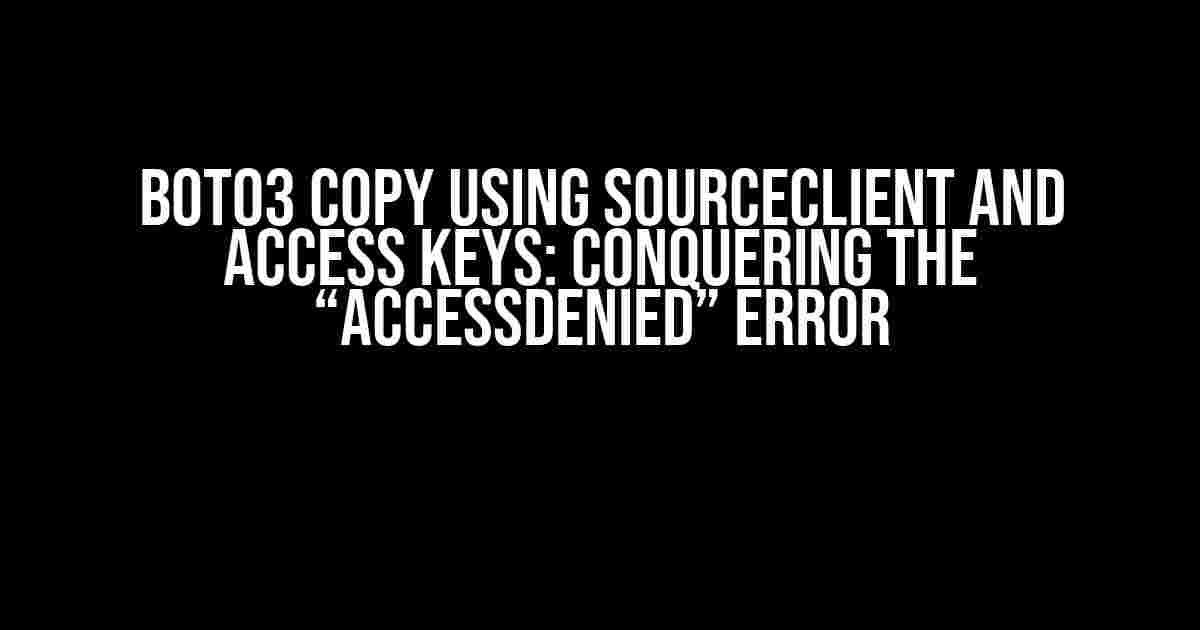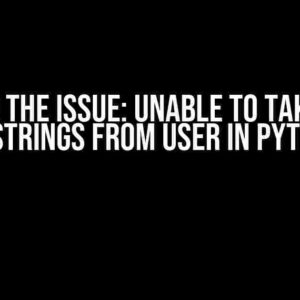The Mysterious Case of AccessDenied
Imagine this: you’re on a mission to copy a massive dataset from one S3 bucket to another using boto3, the popular Python SDK for AWS. You’ve crafted the perfect script, carefully crafting each line of code to ensure a seamless transfer. But, just as you’re about to execute the script, disaster strikes. The program crashes, spitting out a cryptic “AccessDenied” error message. The clock is ticking, and you’re left wondering what went wrong.
The Usual Suspects: SourceClient and Access Keys
In most cases, the “AccessDenied” error is caused by a misconfiguration of the SourceClient and access keys. To understand why, let’s take a step back and examine the anatomy of a boto3 copy operation.
import boto3
s3_src = boto3.client('s3', aws_access_key_id='YOUR_ACCESS_KEY_ID',
aws_secret_access_key='YOUR_SECRET_ACCESS_KEY',
region_name='YOUR_REGION')
s3_dst = boto3.client('s3', aws_access_key_id='YOUR_ACCESS_KEY_ID',
aws_secret_access_key='YOUR_SECRET_ACCESS_KEY',
region_name='YOUR_REGION')
s3_src.copy({'Bucket': 'source-bucket', 'Key': 'source-key'}, 'destination-bucket', 'destination-key')
In the code snippet above, we’re using the boto3 client to create two S3 clients: `s3_src` and `s3_dst`. These clients are configured with your access key ID, secret access key, and region name. The `copy` method is then used to transfer data from the source bucket to the destination bucket.
The Role of SourceClient
The SourceClient is a crucial component of the boto3 copy operation. It’s responsible for authenticating with AWS and providing the necessary credentials to access the source bucket. In our example, the SourceClient is created using the `boto3.client` method, which takes the access key ID, secret access key, and region name as arguments.
Here’s the catch: the SourceClient only works if the access keys have the necessary permissions to read from the source bucket and write to the destination bucket. If the access keys lack the required permissions, the “AccessDenied” error will rear its ugly head.
Troubleshooting the “AccessDenied” Error
Now that we’ve pinpointed the likely culprits, it’s time to troubleshoot the “AccessDenied” error. Follow these steps to resolve the issue:
-
Verify Access Key Permissions
Log in to the AWS Management Console and navigate to the IAM dashboard. Find the access key ID and secret access key used in your boto3 script. Check the permissions associated with these keys. Ensure they have the necessary permissions to read from the source bucket and write to the destination bucket.
Permission Description s3:GetObject Grants permission to read an object from the source bucket s3:PutObject Grants permission to write an object to the destination bucket -
Check Bucket Policies
Navigate to the S3 dashboard and select the source and destination buckets. Check the bucket policies to ensure they allow access from the access keys used in your boto3 script.
{
"Version": "2012-10-17",
"Statement": [
{
"Sid": "AllowCopy",
"Effect": "Allow",
"Principal": "*",
"Action": "s3:GetObject",
"Resource": "arn:aws:s3:::source-bucket/*"
},
{
"Sid": "AllowPut",
"Effect": "Allow",
"Principal": "*",
"Action": "s3:PutObject",
"Resource": "arn:aws:s3:::destination-bucket/*"
}
]
}
-
Verify Region Consistency
Ensure that the region specified in your boto3 script matches the region where the source and destination buckets are located. Inconsistencies in region configuration can lead to “AccessDenied” errors.
-
Rotate Access Keys
If you’ve verified the permissions and bucket policies, try rotating the access keys used in your boto3 script. This can help resolve any issues related to key expiration or revocation.
Best Practices for Using SourceClient and Access Keys
To avoid the “AccessDenied” error and ensure secure boto3 copy operations, follow these best practices:
-
Use IAM Roles Instead of Access Keys
Consider using IAM roles instead of access keys to authenticate with AWS. IAM roles provide temporary credentials that can be used to access AWS resources, eliminating the need for long-term access keys.
-
Limit Access Key Permissions
Grant access keys only the necessary permissions to perform the required actions. This principle of least privilege reduces the risk of unauthorized access to your AWS resources.
-
Rotate Access Keys Regularly
Rotate access keys regularly to minimize the risk of key compromise. You can use AWS IAM’s automatic key rotation feature to simplify this process.
-
Monitor AWS CloudTrail Logs
Enable AWS CloudTrail to monitor and log all AWS API calls, including those made by your boto3 script. This helps you detect and respond to security incidents more effectively.
Conclusion
In conclusion, the “AccessDenied” error when using boto3’s SourceClient and access keys can be a frustrating experience. However, by following the troubleshooting steps and best practices outlined in this article, you’ll be well-equipped to overcome this obstacle and ensure secure and efficient boto3 copy operations.
Remember to verify access key permissions, check bucket policies, ensure region consistency, and rotate access keys regularly. By doing so, you’ll be able to conquer the “AccessDenied” error and successfully transfer your data using boto3.
Happy coding!
Frequently Asked Question
Get answers to your boto3 copy using SourceClient and access keys “AccessDenied” woes!
Q: Why do I get an “AccessDenied” error when using boto3 copy with SourceClient and access keys?
This error usually occurs when the AWS access keys used do not have the necessary permissions to read from the source bucket or write to the destination bucket. Make sure the IAM user or role associated with the access keys has the required permissions, such as s3:GetObject and s3:PutObject.
Q: How do I troubleshoot the “AccessDenied” error when using boto3 copy with SourceClient and access keys?
To troubleshoot, try enabling AWS CloudTrail logging to track API calls and identify the specific error. You can also check the IAM user or role’s permissions by using the AWS CLI command `aws iam get-user` or `aws iam get-role`. Finally, verify that the access keys are not expired or invalid.
Q: Can I use temporary security credentials with boto3 copy using SourceClient and access keys?
Yes, you can use temporary security credentials obtained through AWS STS (Security Token Service) with boto3 copy. This can help mitigate the “AccessDenied” error by ensuring the credentials have the necessary permissions. Use the `aws sts get-session-token` command to obtain temporary credentials.
Q: How do I handle the “AccessDenied” error when copying large files using boto3 copy with SourceClient and access keys?
When copying large files, it’s essential to handle the “AccessDenied” error gracefully. You can use retries with exponential backoff to handle temporary permission issues. Additionally, consider using multipart uploads to reduce the impact of failed uploads. Boto3 provides built-in support for multipart uploads, which can help mitigate the error.
Q: Are there any best practices for securing my access keys when using boto3 copy with SourceClient and access keys?
Yes, always handle access keys securely. Store them in a secure location, such as AWS Secrets Manager or HashiCorp’s Vault. Use IAM roles instead of access keys whenever possible. Rotate access keys regularly, and avoid hardcoding them in your application. When using boto3, consider using the default credential provider chain, which prioritizes credentials from environment variables, the shared credentials file, and finally the AWS config file.



